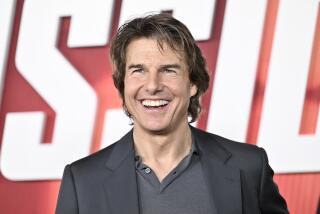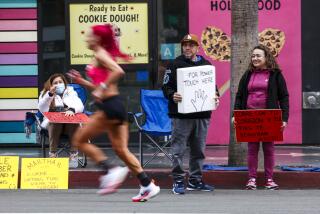Going on Tour Is More Than Just a Long Bike Ride
- Share via
Psychiatrist Lewis S. Lane, who will leave Friday for Marseilles, France, to ride alongside some of the world’s great bicyclists in the Tour de France, said he is joining the tour to give meaning to his years of cycling.
“This is the pinnacle of the cycling world, and I thought wouldn’t it be great if I could get as close to participating as anyone can be,” said Lane, who has taken a two-week break as a biological psychiatrist at Capistrano by the Sea Hospital in Dana Point.
Lane said turning 40 also had a lot to do with the ride he is taking with 29 other “officially unofficial” cyclists who will pedal as a group on the Tour de France course which winds 2,000 miles around France.
“I’ve traveled around the world surfing, but now I’m focusing on cycling, and I thought I could validate my commitment to the sport with the race,” said Lane, a UCLA graduate who keeps a bicycle in his car.
A Laguna Beach resident, Lane said he has been in training for the past 13 weeks, cycling 100 miles a week and more, much of it on the 1984 Olympics bicycle course in Mission Viejo. He added that he often rides in the hills near his office to get in some extra training miles.
“Being in the race has a lot to do with turning 40. It’s the beginning of a whole different decade of my life,” he said. “I’m not into cycling for competition. I’m into it for personal fitness and training. . . . I plan on going into my middle years being in good shape.”
Whatever his reasons, he’ll have a lot of people watching him since the race attracts an estimated 50 million onlookers. It also has added interest this year since it is France’s bicentennial.
But the major thrust of the 12 days he will be riding in the Tour de France race is to “make it through the L’Alpe de Huez,” the final leg of an arduous uphill ride on July 19.
“Those who have done it report that just when you reach an absolute physical exhaustion and feel you can’t go on, there is a nine-mile uphill stretch,” he said.
Just in case, the 30-member group will have its own support van following it to carry those who can’t make the grueling climb.
Lane said his personal goal is to finish on top of the mountain, the final part of that leg of the race.
“I’m going to buy a yellow jersey when the race is over no matter how I do,” said Lane, a reference to the traditional yellow jersey given each year to the winner of the Tour de France.
“In my mind, just riding in the race is winning,” he said. “It doesn’t have to be the real one. To me it will be the same.”
Gary Lee Owsley said he always has been sensitive to owls, noting that his name has its roots from ancestors who lived near the Owls River in England.
Since birds of a feather flock together, so to speak, it turned out that Owsley, an Edison Co. electrical service crew foreman, was called to rescue an owl trapped in a wire atop a power pole in his hometown of Huntington Beach.
When Owsley arrived, the barn owl was unceremoniously hanging upside down on an energized wire. With the aid of co-worker Steve Dykes of Lakewood, Owsley was able to free the bird, which was last seen winging its way to a nearby tree.
And wouldn’t you know, the pole from which the owl was rescued is located on Birdie Lane.
Technology is even changing the shoes that horses wear, says veteran horseshoer Sam Royster of Anaheim, who will work as the shoeing inspector during the Orange County Racing Fair at Los Alamitos Race Course that opens July 25 and runs through Aug. 12.
He said everyone from space age engineers to veterinarians are trying to develop a better
horseshoe.
“Every six months, someone comes up with something new,” said Royster, who added that thoroughbreds and quarter horses both are using lighter weight aluminum racing shoes instead of steel shoes.


